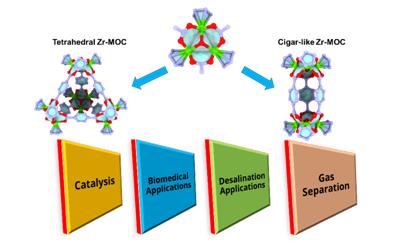Compared with other porous framework materials such as metal-organic frameworks (MOFs) and covalent organic frameworks (COFs), the unique feature of Metal-organic cages (MOCs) is their discrete modular nature. Their relatively isolated porous molecular units can be effectively dispersed in solutions or other doping systems, making them processable in particular applications.In addition, the stacking mode of molecular cages varies, making coordination molecular cages as solid materials not only realize various supramolecular framework connections but also can be endowed with various functions through post-modification..
A research team led by Prof. YUAN Daqiang from Fujian Institute of Research on the Structure of Matter (FJIRSM) of the Chinese Academy of Sciences, in collaboration with Prof. ZHAO Dan, from National University of Singapore (NUS), reviewed the synthesis and applications of Zr-MOCs and systematically summarized their assembly rules in addition to their elaborated-related synthesis methods and strategies.
The study was published in Acc. Chem. Res..
The researchers summarized the employment of Zr-MOCs in catalysis, biomedicine, desalination, and gas sorption and separation, and prospected the future development of Zr-MOCs.
The team highlighted the development of Zr-MOCs along with their respective applications. They presented the primary assembly of monometallic and heterometallic Zr-MOCs based on tetrahedral and cigar-like geometries. The tetrahedral cage shapes are produced when linear organic ligands are employed, whereas cigar-like shapes are developed based on bent or angular organic ligands.
The researchers realized the postsynthetic modification (PSM) reactions of Zr-MOCs by selecting ZrT-1-NH2 as the well-suited example due to its stability, solubility, processability, and functionality. This cage underwent several reactions between its amino groups and flexible acyl chloride linkers to link Zr-MOC molecules, formaldehyde (Mannich reaction) to inspect the cage processability, tetrazole to form a functional cage for gas separation, acrylate to yield homoporous hybrid membranes, and terephthaldehyde to produce membranes based on hyprcrosslinked cages.
After presenting the primary assembly of Zr-MOCs and their PSM reactions, the researchers also highlighted their hierarchical assembly into higher assembled superstructures with high dimensionality. They introduced the further assembly of Zr-MOCs into hydrogen-bonded organic frameworks when D-camphoric acid was used as the ligand with hydrogen bonding sites. The cationic nature of Zr-MOCs makes them amenable to further neutralization with anionic cages to produce doubly porous salts.
The researchers also reviewed different Zr-MOC applications based on their properties and functionality. The applications include catalysis, adsorption, water desalination, gas separation, and biomedical use. They demonstrated that most applications are based on functional cages with NH2, SH, N, SO2, N2, imidazolium, tetrazole, and sulfonate groups.
This study helps to rationally design new cages with more functionalities to target new applications such as building conductive cages.

Schematic illustration of the assembly and diverse applications of zirconium-based metal-organic cages. (Image by Prof. YUAN’s group).
Contact:
Prof. YUAN Daqiang
Fujian Institute of Research on the Structure of Matter
Chinese Academy of Sciences
E-mail: ydq@fjirsm.ac.cn